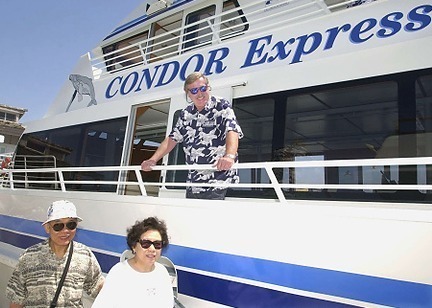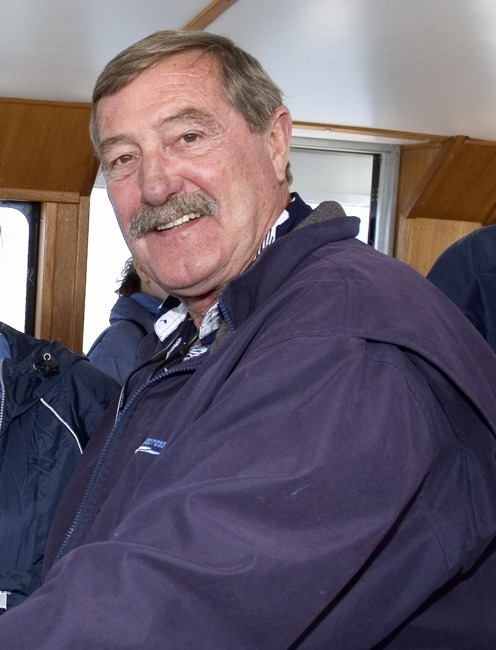The following is an excerpt taken from an article written in the Monteceito Journal, April 12, 2007, By Thedim Fiste, titled "Casa and the Club."
Fred Benko was drawn to CASA partly – or chiefly – because of his own early life. His mother was a divorced single mom who worked as a “barrage balloon” seamstress at a B.F. Goodrich plant during WWII. “During that era,” Fred relates, “she really couldn’t afford to keep her kid, so I got shopped around a lot. There wasn’t a big foster care network at that time.” He lived with aunts and grandparents, “whoever could afford another mouth to feed.” He says it didn’t bother him because he liked most of the people he stayed with. He spent a couple of summers on a muck farm as a kid weeding radish fields with up to 15 other kids. “It was neat,” Fred insists. “These people would take in twelve, fifteen kids and they’d feed us –mashed potatoes, biscuits and gravy, three meals a day – and we’d work in the fields.”
He says that as the smallest kid at a table of twelve with only one plate of mashed potatoes in the middle, one has either got to be the strongest kid at the table or one must use guile to get one’s share. “This is not unlike the modern-day shelters,” Maria observes. “Unless you’ve never had it, that experience stays with you for the rest of your life.”
“There’s a reason that those of us who get involved with CASA get involved,” Fred adds. “Part of it is because we want to help the kids that are here and a lot of that is because we have an idea what they’re going through. And, I’ve been there. I was not abandoned by my mother. I was always in contact with her but I didn’t live with her on a day-to-day basis. I did not think I had a bad upbringing as a child,” he continues. “The only bad thing I had was an abusive stepfather, so anywhere else I was, was just fine with me. I had a great time. I really think these kids have it a lot more serious than I did.” Maria, who was orphaned as a teenager also knows what it’s like to be thrust into the court system. She says her Midwest upbringing gave her the stamina to survive, but feels that kind of cultural foundation is missing from most of these kids’ lives.
Fred became a camp counselor at Camp Y-Noah in Akron Ohio – where the soapbox derby takes place – when he was about 14. He remembers that many kids would complain of being homesick while at camp, and says that was something he could not relate to at all. He always looked forward to being shopped around to other homes. Fred’s favorite was Aunt Mildred, but there was Aunt Tessie in Lima who took pretty good care of him, and there were others too.
The Larry Sutton Story
Until he was adopted by his stepfather, Fred’s name was Larry Sutton, his real father’s name. “My [maternal] grandfather’s name was Fred – Fritz – and everybody always called me ‘Little Freddy,’ he explains. “It was only the first day of school that anybody ever called me ‘Larry.’ I would tell the teacher, ‘No, no. Call me Freddy.’”
Nearly two decades after World War II, Fred’s mother enrolled at Akron University and earned her degree, becoming a teacher at the age of 40. Both she and her son, coincidentally, attended college at the same time. Fred attended Akron University for one semester but switched to Wooster in Ohio for a couple of years. He joined the Marines at the advice of a judge, and when he got out, found a job with Pfizer Labs who sent him to George Washington University, where he received an MBA. Afterwards, he was sent to California as a district manager for Pfizer and rose to become regional manager.
Fred never saw the ocean until he was on his way to Parris Island Marine boot camp in South Carolina in 1959, but he’d always had boats, he says, having grown up around lakes and was an avid fisherman. “After I got out of boot camp,” he relates, “they sent me up to Cherry Point [North Carolina] and I started commercial fishing.” He had a dentist friend who had a boat and the two of them fished on weekends. The dentist let Fred fish during the week when he was busy with his patients.
Fred claims he had the best job in the Marine Corps; he was a hurricane forecaster in North Carolina and later, a typhoon forecaster in Japan. He says a hurricane is the same as a typhoon, just with a different name. “In Australia, they call [hurricanes] Willy Willy,” he says, as if we understood. Fred says he and his team “flew right into the hurricanes,” because in order to really follow storms in those days, “you needed to stay on top of them all the time – this was before satellites. You just had to voodoo it in,” he laughs. Apparently, to be effective at hurricane and typhoon or Willy Willy tracking, it was best to work a 24-hour shift, so he did – and then received 72 hours off before the next shift. He admits that storms were difficult to predict in Japan “because China and Russia sent us no information. Most of your weather comes from the west, so if you didn’t know what was coming at you, you couldn’t tell what was over here. It really was voodoo.”
He was a Marine, just “in time to be trained for the Bay of Pigs invasion,” he says. “I was in the air at the Marine Corps station in Puerto Rico ready to be dropped in [to Cuba] and then Kennedy pulled us back.”
Fred The Folk Singer
In addition to his Marine Corps experience, his career with Pfizer and his life as captain of the Condor and Condor Express, Fred experienced a short musical detour.
“Not many people know this,” he says, “but when I was a kid of about seven or eight years old, I was taken into the Harvey Firestone Chorus at the Akron Ohio Episcopalian Church that he built. It was a two-hundred-and-twenty-five-voice all-male chorus. We recorded; we toured. I started as a little kid with a trained voice, so when that happens you end up having a pretty good voice even when you’re an adult.” Anyone who heard Fred sing at the most recent Red Feather Ball now understands where and how he learned mastery of stage presence and voice projection, and why he looked so darned happy and comfortable on stage.
“I used to be a folk singer,” Fred says matter of factly. “I had a group called ‘The Beachers Three’ and we used to steal songs from the Kingston Trio and the Limelighters until we started writing our own songs.” The Beachers Three were all in the Marine Corps at the time so when Fred’s two singing mates were shipped out that left him on his own. He played the guitar and sang up and down the Eastern Seaboard, from Virginia, North Carolina, and South Carolina to Georgia and northern Florida. “I was there about the same time as Jimmy Buffet was and we were on the same circuit and would occasionally run into one another,” Fred recalls. “We’re not friends, but we did meet, and I’m still a fan.”
Fred was playing at The Cellar Door in Washington, D.C. when a man walked in, announced that he was Connie B. Gay and wanted Fred to join an ‘Americana’ music tour of Europe he was putting together; they had jazz, blues, folk, and country/western. Fred said ‘sure,’ and ended up on stage in Amsterdam the night John Kennedy was shot. Immediately upon the announcement of the news, the show was stopped and the entire ensemble was put on a plane and flown back to Washington D.C. “As we were driving back to the airport,” Fred recalls with wonderment, “every single house had a black flag flying from the window. Every house that we passed had those black flags because John Kennedy had been shot.” He wondered whether that would happen today.
Back to California
After his folk-singing career and Marine tour of duty ended, Fred stayed with Pfizer until they asked him to return to New York City as a vice president. By then, he had his boat, and he was diving and fishing, so he declined. “I just couldn’t do it,” he says. “I just didn’t want to live in New York City, or work in New York City and live in Connecticut and commute for two hours a day. I had kids. So I quit Pfizer; they were amazed that I would leave, but I did and started Sea Landing.” During this time, Fred’s wife, Patty, died of cancer.
Hiroko had just moved to Montecito from Pasadena when she and Fred met in early 1985 on his boat during a party cruise. “She came out again, and then again,” Fred says with a smile. The two were married in September of that same year.
Hiroko is, among other things, an artist of some note and is currently busy creating an auction item to sell during this year’s CASA event. Maria believes it will prove to be “one of the monumental art projects offered for this particular event.” Hiroko has created platters upon which her stencils will be painted by the children. “I expect these will be works of art far beyond anybody’s expectations,” Maria says.
View the Complete article at: http://www.montecitojournal.net/archive/13/15/921/




